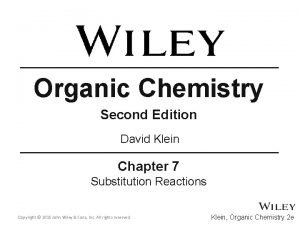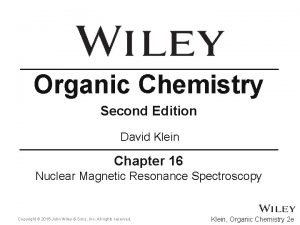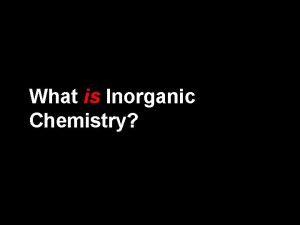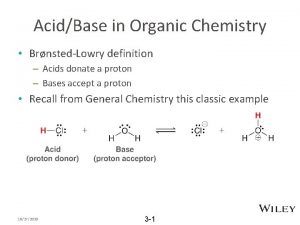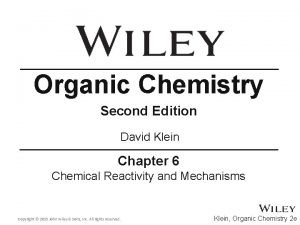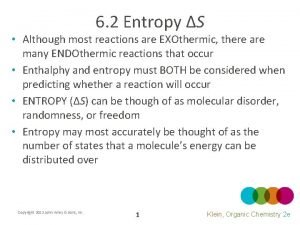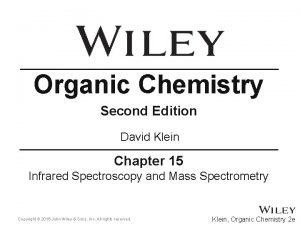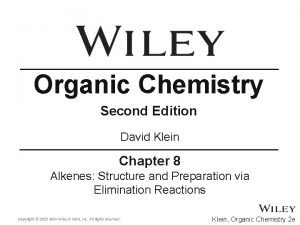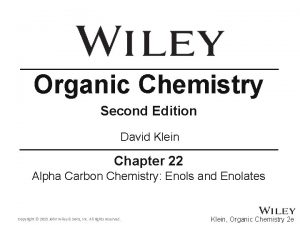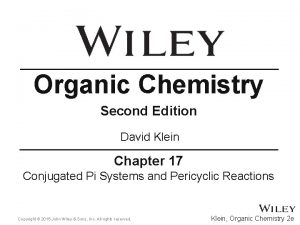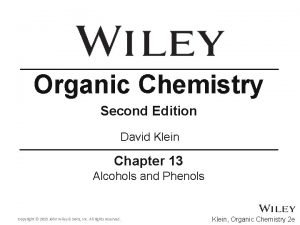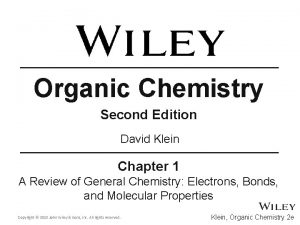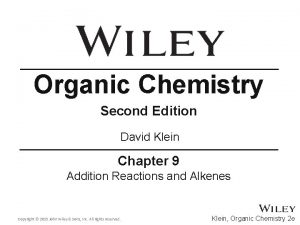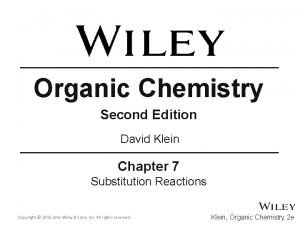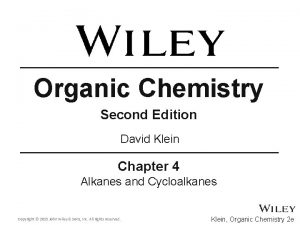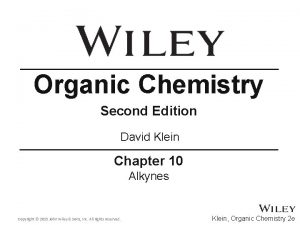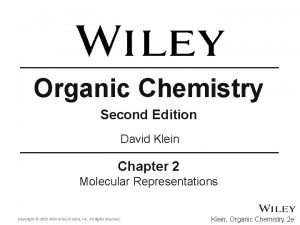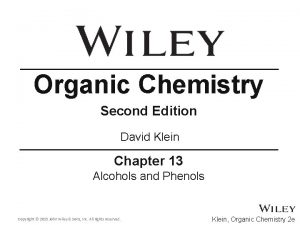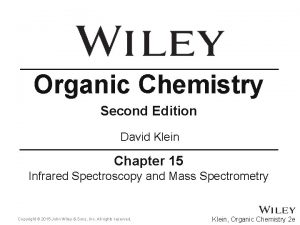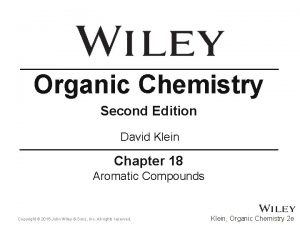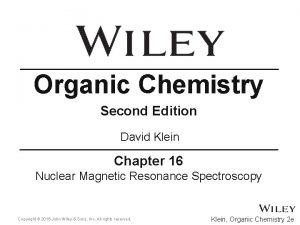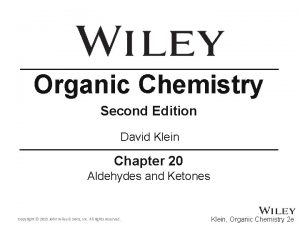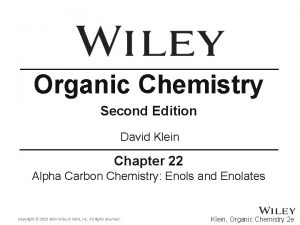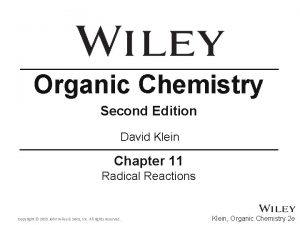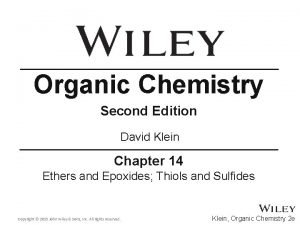Organic Chemistry Second Edition David Klein Chapter 14
























































- Slides: 56

Organic Chemistry Second Edition David Klein Chapter 14 Ethers and Epoxides; Thiols and Sulfides Copyright © 2015 John Wiley & Sons, Inc. All rights reserved. Klein, Organic Chemistry 2 e

14. 1 Introduction to Ethers • An ether group includes an oxygen atom that is bonded to TWO –R groups • -R groups can be alkyl, aryl, or vinyl groups • Would the compound below be considered an ether? Copyright © 2015 John Wiley & Sons, Inc. All rights reserved. 14 -2 Klein, Organic Chemistry 2 e

14. 4 Crown Ethers • Metal atoms with a full or partial positive charge can be stabilized by ether solvents • Ethers are generally used as the solvent in the Grignard reaction • Give another reason why an ether makes a good solvent in this reaction Copyright © 2015 John Wiley & Sons, Inc. All rights reserved. 14 -3 Klein, Organic Chemistry 2 e

14. 4 Crown Ethers • Crown ethers have been shown to form especially strong attractions to metal atoms. WHY? • Note how many carbon atoms separate the oxygens • Why are they called CROWN ethers? • Explain the numbers found in their names Copyright © 2015 John Wiley & Sons, Inc. All rights reserved. 14 -4 Klein, Organic Chemistry 2 e

14. 4 Crown Ethers • The size of the metal must match the size of the crown to form a strong attraction • 18 -crown-6 fits a K+ ion just right Copyright © 2015 John Wiley & Sons, Inc. All rights reserved. 14 -5 Klein, Organic Chemistry 2 e

14. 4 Crown Ethers • Normally metal ions are not soluble in low polarity solvents. WHY? • The crown ether – metal complex should dissolve nicely in low polarity solvents. WHY? • Imagine how a crown ether could be used to aid reactions between ion (especially anions) and low polarity organic substrates Copyright © 2015 John Wiley & Sons, Inc. All rights reserved. 14 -6 Klein, Organic Chemistry 2 e

14. 4 Crown Ethers • The F- ion below is ready to react because the K+ ion is sequestered by the crown ether • Without the crown ether, the solubility of KF in benzene is miniscule Copyright © 2015 John Wiley & Sons, Inc. All rights reserved. 14 -7 Klein, Organic Chemistry 2 e

14. 4 Crown Ethers • Generally, F- ion is not used as a nucleophile, because it is strongly solvated by polar solvents • Such solvation greatly reduces its nucleophilic strength • In the presence of the crown ether, it is soluble enough in a nonpolar solvent that it can readily attack an electrophile Copyright © 2015 John Wiley & Sons, Inc. All rights reserved. 14 -8 Klein, Organic Chemistry 2 e

14. 4 Crown Ethers • Smaller crown ethers bind smaller cations • Practice with conceptual checkpoint 14. 4 Copyright © 2015 John Wiley & Sons, Inc. All rights reserved. 14 -9 Klein, Organic Chemistry 2 e

14. 5 Preparation of Ethers • Diethyl ether is prepared industrially by the acidcatalyzed dehydration of ethanol • How is it a dehydration? • Can this method be used to make asymmetrical ethers? Copyright © 2015 John Wiley & Sons, Inc. All rights reserved. 14 -10 Klein, Organic Chemistry 2 e

14. 5 Preparation of Ethers • The Williamson ether synthesis is a viable approach for many asymmetrical ethers • What happens to the halide? Copyright © 2015 John Wiley & Sons, Inc. All rights reserved. 14 -11 Klein, Organic Chemistry 2 e

14. 5 Preparation of Ethers • The Williamson ether synthesis is a viable approach for many asymmetrical ethers • The alkoxide that forms in step 1 is also a strong base • Are elimination products likely for methyl, primary, secondary, or tertiary alkyl halides? Copyright © 2015 John Wiley & Sons, Inc. All rights reserved. 14 -12 Klein, Organic Chemistry 2 e

14. 5 Preparation of Ethers • Use the Williamson ether approach to prepare MTBE • Consider a retrosynthetic disconnect on the t-butyl side • It is better to make your retrosynthetic disconnect on the methyl side. WHY? • Practice with Skill. Builder 14. 2 Copyright © 2015 John Wiley & Sons, Inc. All rights reserved. 14 -13 Klein, Organic Chemistry 2 e

14. 5 Preparation of Ethers Copyright © 2015 John Wiley & Sons, Inc. All rights reserved. 14 -14 Klein, Organic Chemistry 2 e

14. 5 Preparation of Ethers • Recall from section 9. 5 that oxymercurationdemercuration can be used to synthesize alcohols • Is the addition Markovnikov or anti-Markovnikov? • Is the addition syn or anti? Copyright © 2015 John Wiley & Sons, Inc. All rights reserved. 14 -15 Klein, Organic Chemistry 2 e

14. 5 Preparation of Ethers • Similarly, alkoxymercuration-demercuration can be used to synthesize ethers • Is the addition Markovnikov or anti-Markovnikov? • Is the addition syn or anti? • Practice conceptual checkpoints 14. 8– 14. 10 Copyright © 2015 John Wiley & Sons, Inc. All rights reserved. 14 -16 Klein, Organic Chemistry 2 e

Copyright © 2015 John Wiley & Sons, Inc. All rights reserved. Klein, Organic Chemistry 2 e

14. 6 Reactions of Ethers • As we mentioned earlier, because they are aprotic, ethers are generally unreactive • However, ethers can react under the right conditions • Consider the ether below • Where are the most reactive sites? • Is it most likely to react as an acid, base, nucleophile, electrophile, etc. ? Copyright © 2015 John Wiley & Sons, Inc. All rights reserved. 14 -18 Klein, Organic Chemistry 2 e

14. 6 Reactions of Ethers • Ethers can undergo acid-promoted cleavage Copyright © 2015 John Wiley & Sons, Inc. All rights reserved. 14 -19 Klein, Organic Chemistry 2 e

14. 6 Reactions of Ethers • Draw a complete mechanism and predict the products for the following acid-promoted cleavage Copyright © 2015 John Wiley & Sons, Inc. All rights reserved. 14 -20 Klein, Organic Chemistry 2 e

14. 6 Reactions of Ethers • To promote cleavage, HI and HBr are generally effective • HCl is less effective, and HF does not cause significant cleavage • Explain the trend above considering the relative strength of the halide nucleophiles • Why is the cleavage considered acid-promoted rather than acid-catalyzed? • Practice with conceptual checkpoint 14. 11 Copyright © 2015 John Wiley & Sons, Inc. All rights reserved. 14 -21 Klein, Organic Chemistry 2 e

14. 6 Reactions of Ethers • Recall from section 11. 9 that ethers can undergo autooxidation • Hydroperoxides can be explosive, so laboratory samples of ether must be frequently tested for the presence of hydroperoxides before they are used • The autooxidation occurs through a free radical mechanism – see next few slides Copyright © 2015 John Wiley & Sons, Inc. All rights reserved. 14 -22 Klein, Organic Chemistry 2 e

Copyright © 2015 John Wiley & Sons, Inc. All rights reserved. Klein, Organic Chemistry 2 e

14. 8 Preparation of Epoxides • Recall from section 9. 9 that epoxides can be formed when an alkene is treated with a peroxy acid • MCPBA and peroxyacetic acid are most commonly used Copyright © 2015 John Wiley & Sons, Inc. All rights reserved. 14 -24 Klein, Organic Chemistry 2 e

14. 8 Preparation of Epoxides • Recall that the process is stereospecific Copyright © 2015 John Wiley & Sons, Inc. All rights reserved. 14 -25 Klein, Organic Chemistry 2 e

14. 8 Preparation of Epoxides • • Epoxides can also be formed from halohydrins What is a halohydrin? How are halohydrins formed from alkenes? When a Halohydrin is treated with Na. OH, a ring-closing reaction can occur Copyright © 2015 John Wiley & Sons, Inc. All rights reserved. 14 -26 Klein, Organic Chemistry 2 e

14. 8 Preparation of Epoxides Copyright © 2015 John Wiley & Sons, Inc. All rights reserved. 14 -27 Klein, Organic Chemistry 2 e

14. 8 Preparation of Epoxides • Assess the overall stereochemistry of the epoxidation that occurs through the halohydrin intermediate • Practice with Skill. Builder 14. 3 Copyright © 2015 John Wiley & Sons, Inc. All rights reserved. 14 -28 Klein, Organic Chemistry 2 e

Copyright © 2015 John Wiley & Sons, Inc. All rights reserved. Klein, Organic Chemistry 2 e

14. 9 Enantioselective Epoxidation • The epoxidation methods we have discussed so far are NOT enantioselective • Draw the products racemic mixture Copyright © 2015 John Wiley & Sons, Inc. All rights reserved. 14 -30 Klein, Organic Chemistry 2 e

14. 9 Enantioselective Epoxidation • The epoxidation forms a racemic mixture, because the flat alkene can react on either face Copyright © 2015 John Wiley & Sons, Inc. All rights reserved. 14 -31 Klein, Organic Chemistry 2 e

14. 10 Ring-opening of Epoxides • Because of their significant ring strain, epoxides have great synthetic utility as intermediates • Propose some reagents that might react with an epoxide to provide a specific functional group • Propose some reagents that might react with an epoxide to alter the carbon skeleton Copyright © 2015 John Wiley & Sons, Inc. All rights reserved. 14 -32 Klein, Organic Chemistry 2 e

14. 10 Ring-opening of Epoxides • Strong nucleophiles react readily with epoxides Copyright © 2015 John Wiley & Sons, Inc. All rights reserved. 14 -33 Klein, Organic Chemistry 2 e

14. 10 Ring-opening of Epoxides • In general, alkoxides are not good leaving groups • The ring strain associated with the epoxide increases its potential energy making it more reactive– see the energy diagram on the next slide Copyright © 2015 John Wiley & Sons, Inc. All rights reserved. 14 -34 Klein, Organic Chemistry 2 e

14. 10 Ring-opening of Epoxides • Epoxides can be opened by many other strong nucleophiles as well • Both regioselectivity and stereoselectivity must be considered – see next few slides Copyright © 2015 John Wiley & Sons, Inc. All rights reserved. 14 -35 Klein, Organic Chemistry 2 e

14. 10 Ring-opening of Epoxides • Given that the epoxide ring-opening is SN 2, predict the outcome of the following reactions • Pay attention to regio- and stereoselectivity. EXPLAIN WHY • Practice with Skill. Builder 14. 4 Copyright © 2015 John Wiley & Sons, Inc. All rights reserved. 14 -36 Klein, Organic Chemistry 2 e

Copyright © 2015 John Wiley & Sons, Inc. All rights reserved. Klein, Organic Chemistry 2 e

14. 10 Ring-opening of Epoxides • Acidic conditions can also be used to open epoxides Copyright © 2015 John Wiley & Sons, Inc. All rights reserved. 14 -38 Klein, Organic Chemistry 2 e

14. 10 Ring-opening of Epoxides • Water or an alcohol can also be used as the nucleophile under acidic conditions • Predict the products and draw a complete mechanism • Antifreeze (ethylene glycol) is made industrially by this method Copyright © 2015 John Wiley & Sons, Inc. All rights reserved. 14 -39 Klein, Organic Chemistry 2 e

14. 10 Ring-opening of Epoxides • If the nucleophile preferentially attacks the tertiary carbon under acidic conditions, is the mechanism likely SN 1 or SN 2? • Considering the observations below, is the mechanism likely SN 1 or SN 2? Copyright © 2015 John Wiley & Sons, Inc. All rights reserved. 14 -40 Klein, Organic Chemistry 2 e

14. 10 Ring-opening of Epoxides • When the nucleophile attacks a tertiary center of the epoxide, the intermediate it attacks takes on some carbocation character (SN 1), but not completely • Give reaction conditions for the following reaction • Practice with Skill. Builder 14. 5 Copyright © 2015 John Wiley & Sons, Inc. All rights reserved. 14 -41 Klein, Organic Chemistry 2 e

14. 11 Thiols and Sulfides • Sulfur appears just under oxygen on the periodic table • Sulfur appears in thiols as an –SH group analogous to the –OH group in alcohols • The name of a compound with an –SH group ends in “thiol” rather than “ol” • Note that the “e” of butane is not dropped in the name of the thiol Copyright © 2015 John Wiley & Sons, Inc. All rights reserved. 14 -42 Klein, Organic Chemistry 2 e

14. 11 Thiols and Sulfides • Thiols are known for their unpleasant odor • Skunks use thiols as a defense mechanism • Methanethiol is added to natural gas (methane) so that gas leaks can be detected • Your nose is a very sensitive instrument • The hydrosulfide ion (HS-) is a strong nucleophile and a weak base • HS- promotes SN 2 rather than E 2 Copyright © 2015 John Wiley & Sons, Inc. All rights reserved. 14 -43 Klein, Organic Chemistry 2 e

14. 11 Thiols and Sulfides • Predict the outcome of the following reactions, and draw a complete mechanism • Practice with conceptual checkpoint 14. 22 Copyright © 2015 John Wiley & Sons, Inc. All rights reserved. 14 -44 Klein, Organic Chemistry 2 e

Copyright © 2015 John Wiley & Sons, Inc. All rights reserved. Klein, Organic Chemistry 2 e

14. 12 Synthetic Strategies Involving Epoxides • Epoxides can be used to install functional groups on adjacent carbons • Give necessary reagents for the reaction below • Practice with Skill. Builder 14. 6 Copyright © 2015 John Wiley & Sons, Inc. All rights reserved. 14 -46 Klein, Organic Chemistry 2 e

Copyright © 2015 John Wiley & Sons, Inc. All rights reserved. Klein, Organic Chemistry 2 e

14. 12 Synthetic Strategies Involving Epoxides • By reacting an epoxide with a Grignard reagent, the carbon skeleton can be modified • You may think of an epoxide as the starting material Copyright © 2015 John Wiley & Sons, Inc. All rights reserved. 14 -48 Klein, Organic Chemistry 2 e

14. 12 Synthetic Strategies Involving Epoxides • An epoxide can be used to install a two carbon chain between an R group and an OH group • Recall that a carbonyl can be used to install a one carbon chain between an R group and an OH group Copyright © 2015 John Wiley & Sons, Inc. All rights reserved. 14 -49 Klein, Organic Chemistry 2 e

14. 12 Synthetic Strategies Involving Epoxides • Give necessary reagents for the reaction below • Practice with Skill. Builder 14. 7 Copyright © 2015 John Wiley & Sons, Inc. All rights reserved. 14 -50 Klein, Organic Chemistry 2 e

Copyright © 2015 John Wiley & Sons, Inc. All rights reserved. Klein, Organic Chemistry 2 e

Copyright © 2015 John Wiley & Sons, Inc. All rights reserved. Klein, Organic Chemistry 2 e

Copyright © 2015 John Wiley & Sons, Inc. All rights reserved. Klein, Organic Chemistry 2 e

Additional Practice Problems • Fill in the missing intermediates and reagents in the scheme below Copyright © 2015 John Wiley & Sons, Inc. All rights reserved. 14 -54 Klein, Organic Chemistry 2 e

Additional Practice Problems • Fill in the missing intermediates and reagents in the scheme below Copyright © 2015 John Wiley & Sons, Inc. All rights reserved. 14 -55 Klein, Organic Chemistry 2 e

Additional Practice Problems • Give necessary reagents to complete the synthesis below Copyright © 2015 John Wiley & Sons, Inc. All rights reserved. 14 -56 Klein, Organic Chemistry 2 e
 Organic chemistry second edition david klein
Organic chemistry second edition david klein Organic chemistry david klein 3rd edition
Organic chemistry david klein 3rd edition Nomenclature of ethers
Nomenclature of ethers Organic chemistry third edition david klein
Organic chemistry third edition david klein Organic chemistry third edition david klein
Organic chemistry third edition david klein Klein organic chemistry 2nd edition
Klein organic chemistry 2nd edition Thermodynamic control
Thermodynamic control Thermodynamic vs kinetic control
Thermodynamic vs kinetic control Halohydrin
Halohydrin Ib chemistry functional groups
Ib chemistry functional groups Inorganic vs organic chemistry
Inorganic vs organic chemistry Importance of organic compounds
Importance of organic compounds Chapter 22 review organic chemistry section 1 answers
Chapter 22 review organic chemistry section 1 answers Organic chemistry chapter 9
Organic chemistry chapter 9 What functional group is ch3
What functional group is ch3 Nonene
Nonene Analytical chemistry chapters
Analytical chemistry chapters David klein
David klein David klein
David klein Cycloalkanes
Cycloalkanes Canola oil
Canola oil Ester organic chemistry
Ester organic chemistry Nonene
Nonene Ee organic chemistry
Ee organic chemistry Leveling effect organic chemistry
Leveling effect organic chemistry Ario practice problems
Ario practice problems Organic chemistry naming
Organic chemistry naming Objective lab report example
Objective lab report example Organic chemistry conversion chart
Organic chemistry conversion chart Grade 10 organic chemistry
Grade 10 organic chemistry Cyclo organic chemistry
Cyclo organic chemistry Kiliani fischer synthesis
Kiliani fischer synthesis Méth eth prop but pent
Méth eth prop but pent Cracking organic chemistry
Cracking organic chemistry Met et prop but pent hex hept oct non dec undec
Met et prop but pent hex hept oct non dec undec Organic chemistry myanmar
Organic chemistry myanmar Ethene hbr
Ethene hbr Alpha cleavage
Alpha cleavage Hono organic chemistry
Hono organic chemistry Father of organic chemistry
Father of organic chemistry Organic chemistry topic 11
Organic chemistry topic 11 Organic chemistry reaction pathways
Organic chemistry reaction pathways Alkene alcohol naming
Alkene alcohol naming What is organic chemistry like
What is organic chemistry like Ch4o organic or inorganic
Ch4o organic or inorganic Organic chemistry vocabulary
Organic chemistry vocabulary Separation scheme of caffeine from vivarin tablets
Separation scheme of caffeine from vivarin tablets A level chemistry ocr organic synthesis
A level chemistry ocr organic synthesis Rancidity chemical reaction
Rancidity chemical reaction Ario organic chemistry
Ario organic chemistry Calculating percentage yield
Calculating percentage yield Polarimetry organic chemistry
Polarimetry organic chemistry Organic chemistry
Organic chemistry Hammond's postulate organic chemistry
Hammond's postulate organic chemistry Organic chemistry case studies
Organic chemistry case studies Hammond's postulate organic chemistry
Hammond's postulate organic chemistry Structure and bonding in organic chemistry
Structure and bonding in organic chemistry

















